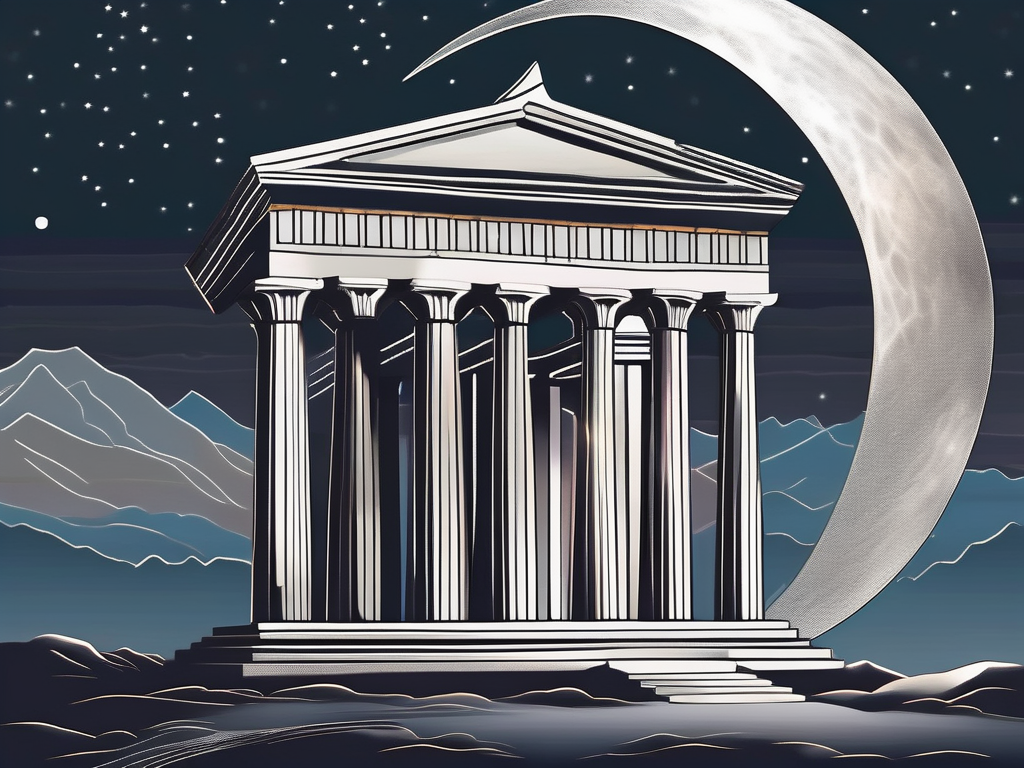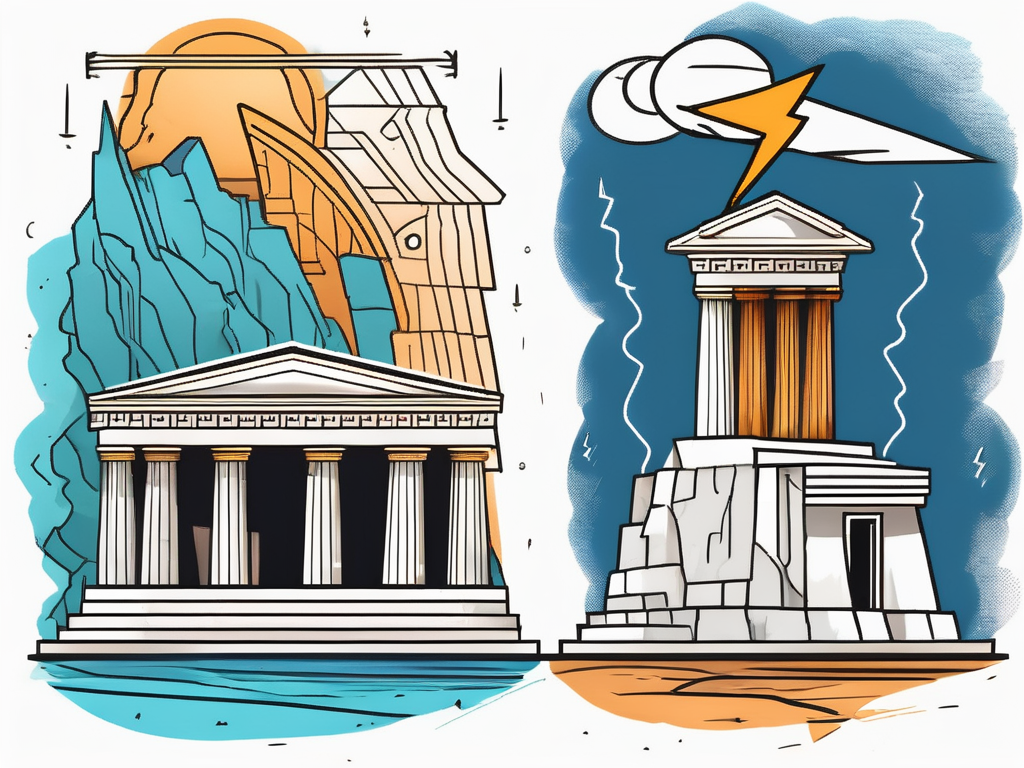In the vast pantheon of ancient Egyptian gods and goddesses, one deity stands out as a fascinating figure shrouded in myth and mystery. Iah, the Egyptian god associated with the moon, has captured the imagination of scholars and enthusiasts alike. Exploring the origins, mythology, symbolisms, and modern influences of Iah not only provides insight into the ancient Egyptian culture but also reveals the enduring power of mythology in shaping our worldviews.
Understanding the Origins of Iah
To comprehend Iah’s significance, it is essential to delve into the origins of this enigmatic deity’s name. The name “Iah” has deep roots in the ancient Egyptian language, with its meaning closely tied to the moon itself. In the ancient Egyptian language, “Iah” translates to “moon” or “moon god,” emphasizing the deity’s association with this celestial body.
Ancient Egyptians held a deep reverence for the moon, considering it a symbol of divine power and a source of illumination in the night sky. The moon’s cyclical phases were seen as a reflection of the eternal cycle of life and death, and Iah was believed to be the guardian and overseer of these celestial transformations.
The Name and Its Meaning
The name “Iah” is derived from the hieroglyphic symbol for the moon, which resembles a crescent. This symbol reflects the ancient Egyptians’ perception of the moon as a powerful and celestial force. The association of Iah with the moon embodies the divine qualities attributed to this luminous celestial object.
Furthermore, the crescent shape of the hieroglyphic symbol for the moon also represents the boat that carried the sun god Ra during his nightly journey through the underworld. This connection between Iah and Ra further solidifies Iah’s significance as a deity closely associated with the cosmic forces that governed the Egyptian worldview.
Historical References to Iah
Throughout history, there are references to Iah in ancient Egyptian texts and religious beliefs. In these references, Iah is often described as a protector and guide, carefully watching over the moon and its cyclical phases. The ancient Egyptians believed that Iah’s influence was responsible for the moon’s changing appearance, and worship of Iah was prevalent during various periods of their history.
One notable historical reference to Iah can be found in the Pyramid Texts, a collection of ancient Egyptian religious texts inscribed on the walls of pyramids. These texts contain spells and rituals intended to guide the deceased pharaohs on their journey to the afterlife. In these texts, Iah is mentioned as a deity who assists the pharaoh in navigating the celestial realms and ensuring their safe passage.
Additionally, Iah’s association with the moon is also evident in the ancient Egyptian calendar. The lunar calendar, which was widely used in ancient Egypt, was based on the moon’s cycles and played a crucial role in determining religious festivals and agricultural activities. Iah’s presence in the calendar further highlights the importance of this deity in the daily lives of the ancient Egyptians.
Overall, the origins of Iah and its association with the moon reveal the deep spiritual connection that ancient Egyptians had with the celestial bodies. Iah’s role as a protector and guide, as well as its influence on the moon’s cyclical phases, showcases the intricate beliefs and religious practices of this ancient civilization.
Iah in Egyptian Mythology
As a prominent figure in Egyptian mythology, Iah possesses a unique set of roles and responsibilities within the pantheon of gods and goddesses.
Iah, also known as Yah, is one of the lesser-known deities in Egyptian mythology, but his significance cannot be understated. He is often depicted as a man with a lunar disk on his head, symbolizing his association with the moon. His name, Iah, means “moon” in the ancient Egyptian language, further emphasizing his connection to this celestial body.
While Iah is primarily associated with fertility, growth, and agriculture, his influence extends far beyond these domains. He is believed to be the guardian of the night, watching over the world as it rests in the darkness. It is said that Iah’s gentle presence during the night brings comfort and peace to those who seek solace under the moonlit sky.
Role and Responsibilities of Iah
Iah’s role as a deity of fertility, growth, and agriculture is deeply intertwined with the well-being of the ancient Egyptians. The moon, as it waxes and wanes, is believed to reflect Iah’s power, influencing the growth of crops and the annual flooding of the Nile.
During the flood season, when the Nile overflows its banks, Iah’s influence is at its peak. The fertile soil left behind by the receding waters ensures bountiful harvests and sustains the livelihoods of the people. The ancient Egyptians revered Iah as a deity who ensured the prosperity of their land and people, offering prayers and sacrifices to appease his divine presence.
Moreover, Iah’s association with fertility extends beyond agriculture. He is also believed to bless couples with fertility, aiding in the conception and birth of healthy children. Many couples seeking to start a family would turn to Iah, offering prayers and dedicating offerings in the hopes of his benevolent intervention.
Iah’s Association with the Moon
Iah’s deep connection with the moon is central to Egyptian mythology. The moon’s cycles symbolize the eternal cycle of life, death, and rebirth—an essential concept within ancient Egyptian cosmology. Through this association, Iah exemplifies the rhythm and harmony of the natural order.
As the moon waxes and wanes, Iah’s influence on the world fluctuates, mirroring the ebb and flow of life itself. The ancient Egyptians believed that Iah’s presence during the full moon brought about a sense of renewal and rejuvenation. It was during this time that they would hold special ceremonies and rituals to honor Iah and seek his blessings.
Furthermore, Iah’s association with the moon extends to the realm of magic and divination. The ancient Egyptians believed that Iah’s lunar powers granted him the ability to see into the future and communicate with the spirit world. Priests and priestesses would often invoke Iah’s name during their divination practices, seeking his guidance and wisdom.
In conclusion, Iah’s role in Egyptian mythology goes far beyond his association with fertility, growth, and agriculture. As the moon deity, he embodies the eternal cycle of life, death, and rebirth, bringing harmony and balance to the natural order. His presence in the pantheon of gods and goddesses is a testament to the ancient Egyptians’ deep reverence for the moon and its influence on their lives.
Symbolism and Iconography of Iah
To further understand Iah’s significance, it is crucial to explore the symbolism and iconic representations associated with this mythical deity.
Iah, also known as Yah or Aah, was an important lunar deity in ancient Egyptian mythology. He was considered to be the personification of the moon and was revered for his association with the night sky and its celestial bodies.
One of the most common symbols associated with Iah is the distinctive hieroglyphic symbol of the crescent moon adorning his head. This symbol serves as a visual representation of Iah’s association with the moon, mirroring the celestial connection that the ancient Egyptians believed he embodied. The crescent moon was seen as a symbol of fertility and regeneration, reflecting Iah’s role in the cyclical nature of life.
Apart from the crescent moon, Iah is often depicted with other symbols that represent his divine attributes. These symbols include the ankh, the symbol of life, which signifies Iah’s role as a giver and sustainer of life. Additionally, he is sometimes depicted holding a scepter, symbolizing his authority and power as a deity.
Depictions of Iah in Ancient Art
Ancient Egyptian art frequently portrays Iah as a regal figure, adorned with the iconic symbols and regalia that signify his divine status. Many sculptures and paintings depict Iah as a lunar deity, further emphasizing his connection to the moon and the natural world.
In these artistic representations, Iah is often depicted with a serene expression, symbolizing his calm and peaceful nature. His regal attire, consisting of elaborate headdresses and ornate jewelry, reflects his status as a powerful deity. The artists paid great attention to detail, meticulously carving and painting the intricate designs on these artworks.
Furthermore, Iah is often depicted in a standing or seated position, symbolizing his stability and immortality. These depictions were meant to convey a sense of reverence and awe towards Iah, emphasizing his importance in the Egyptian pantheon.
Ancient Egyptians held Iah in high regard and believed that he played a crucial role in the natural cycles of life. They worshipped him as a benevolent deity who brought light to the darkness of the night and ensured the continuity of life on earth.
In conclusion, the symbolism and iconography associated with Iah provide valuable insights into the ancient Egyptian beliefs and their reverence for the moon and its divine representation. The depictions of Iah in ancient art showcase the artistic skill and religious devotion of the ancient Egyptians, as well as their deep connection to the natural world and the celestial bodies that governed their lives.
Iah’s Influence on Egyptian Culture and Religion
The influence that Iah held over ancient Egyptian culture and religion cannot be understated.
Worship and Rituals of Iah
Iah was a revered god, and his worship was intertwined with the daily lives and rituals of ancient Egyptians. Temples dedicated to Iah were centers of spiritual devotion and played a vital role in the community, offering a haven for individuals seeking blessings for their crops, families, and personal lives.
Iah’s Impact on Egyptian Cosmology
Ancient Egyptian cosmology is deeply interconnected with their religious beliefs, and Iah played a significant role in shaping these conceptions. The moon’s symbolic association with continuity and regeneration found its expression through Iah, providing the ancient Egyptians with a profound understanding of the cyclical nature of life.
Iah’s Presence in Modern Culture
Despite the passage of millennia, Iah’s influence continues to resonate in our modern world.
Iah in Literature and Media
Iah’s mythical aura and association with the moon have inspired countless works of literature and artistic expressions. From poetry to novels and films, Iah’s presence can be felt, reminding us of the enduring power and fascination that ancient Egyptian mythology holds.
Modern Interpretations of Iah
Contemporary interpretations of Iah highlight the intrinsic connection between the ancient and the present. Some individuals incorporate Iah’s symbolism into their spiritual practices or view Iah as a symbol of balance and harmony within the natural world, evoking the same reverence and awe that ancient Egyptians held for this god.
In Conclusion
Iah, the Egyptian god associated with the moon, represents an intriguing sight into the ancient Egyptian culture and belief system. Through his origins, role in mythology, symbolisms, and impact on culture and religion, Iah continues to captivate our imagination. Whether examining ancient Egyptian texts or appreciating Iah’s presence in contemporary works, one cannot deny the transcendence of this mythical deity and his enduring relevance in shaping our understanding of the divine and the natural world.












